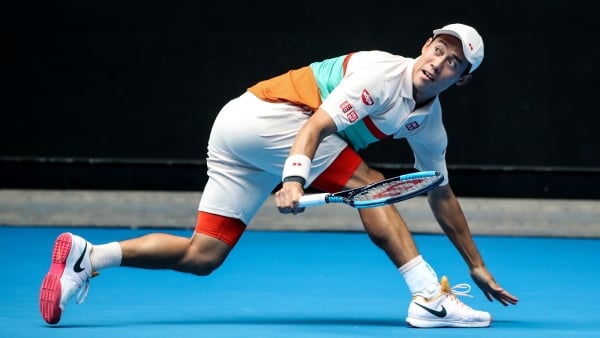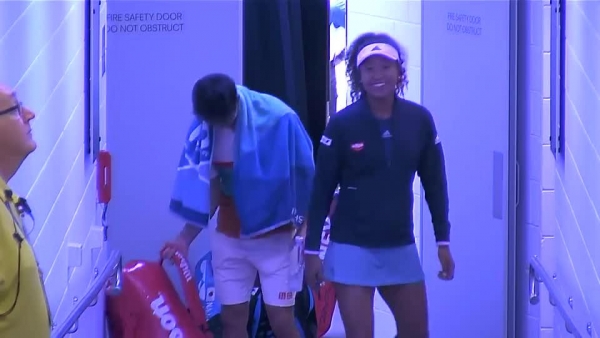Oh to be Japanese and to have had a ticket to the Margaret Court Arena on Thursday. It would have been like all your Christmases coming at once: almost four hours of Kei Nishikori beating Ivo Karlovic followed by 64 minutes of Naomi Osaka walloping Tamara Zidansek. What’s not to love?
We all know about the worldwide popularity of the likes of Roger Federer, Serena Williams, Rafael Nadal and Maria Sharapova – serial Grand Slam winners who have been raking in the trophies for a lifetime. But their fame is as nothing compared to Kei and Naomi back home.
The Japanese are no different to the rest of the world in that they adore Roger and Rafa – but they adore them a lot more when they are playing Kei. And when Naomi beat Serena to win the US Open last year, that took her to a whole new level of celebrity.
Her very next tournament was in Tokyo and the media merry-go-round that accompanied that homecoming had to be seen to be believed. The Toray Pan Pacific Open is a reasonably big event – it is the same level of tournament as the Brisbane International – but the media interest is not usually massive.
Just as at any other tour event around the world, the players’ pre-tournament press conference would normally be attended by a couple of international scribes, a gaggle of local writers and a random radio bloke or two. Maybe local TV might take an interest but, then again, maybe not.
And then there was Naomi’s pre-tournament presser: around 150 journalists turned up and it was standing room only.
MORE: Osaka easily dispenses with Zidansek
Of all the sports stars in Japan, two stand head-and-shoulders above the rest: Shohei Ohtani, the pitcher for the Los Angeles Angels and Naomi. Serena and Fed are both GOATs and living legends but in Japan; Shohei and Naomi are demi-gods.
Grand Slams are a bit different, though. The interest from around the world is huge and space is limited in the media centre. Even so, there are 37 accredited journalists in the press bunker and that does not take television and radio into consideration. When Nishikori’s arrival for his press conference was announced, half the room got up and followed him in.
After reaching the US Open final in 2014, Nishikori qualified for the ATP Tour Finals in London at the O2 Arena. In that vast complex, it is very easy lose people. But not Nishikori. He was always easy to find: he was the only player with at least 30 journalists and five camera crews following his every move. If you wanted to find Kei, you looked for a constantly moving rugby scrum of people and tried to spot the player in the middle of it.
Those same camera crews were chasing anyone and everyone for quotes about their man. Walking in one morning, yours truly was seized by a TV chap and asked to give an opinion on whether Nishikori could reach more Grand Slam finals and win a few of them (I didn’t think he could).
Two days later, the same TV man pounced on me again. I told him he had spoken to me already. Ah, he said, but had I changed my mind in the past 48 hours and would I like to tell him about it? The Japanese appetite for news and information on their sports stars seems to be insatiable.
The Australian Open is, as we all know, the Grand Slam of Asia-Pacific so it hardly comes as a surprise to see a large contingent of Japanese fans packed into the show courts. But they are not like the other fans from around the world.
Take the Greeks, for instance – you hear them before you see them as they sing and chant and generally make loads of noise watching Stefanos Tsitsipas or Maria Sakkari. It is the same with the Serbs when they are watching Djokovic: where is Novak playing? Just follow the singing and you will find him.
But the Japanese – who are possibly the politest people on the planet – sit in nervous silence through every point and only gasp and clap at the appropriate moment when the ball has gone dead. This is, according to my Japanese colleague, is because everyone has grown up watching the television coverage of Wimbledon on their national broadcaster, NHK. The tradition, the etiquette and the deafening Centre Court silence is what they know as the norm and so that is how they behave when they come to Melbourne.
MORE: Nishikori outlasts Karlovic in five-set thriller
That is not to say they are not a colourful bunch. Armed with flags and fans, banners and posters, they make their allegiance known. Their faces painted with the Japanese flag and their bandanas decorated with the rising sun, they look so excited that they might burst. Admittedly, the face painted fan with a Japanese flag and a padded hat in the shape of a frog caused a little confusion (as did the bloke in the chicken hat) but there was no doubting their country of origin or who they had cone to support.
And when Nishikori let slip a two set lead against Karlovic and then went 0-40 down in the heart of the fifth, these devoted followers could barely breathe. By the time he had lost his lead in the match tiebreak, they had almost gone blue in the face. But then, after three hours and 48 minutes when Nishikori finally claimed his place in the third round, they all exhaled as one and all was well with their world.
Now, if their nerves can take it, they get to do it all over again on Saturday.

